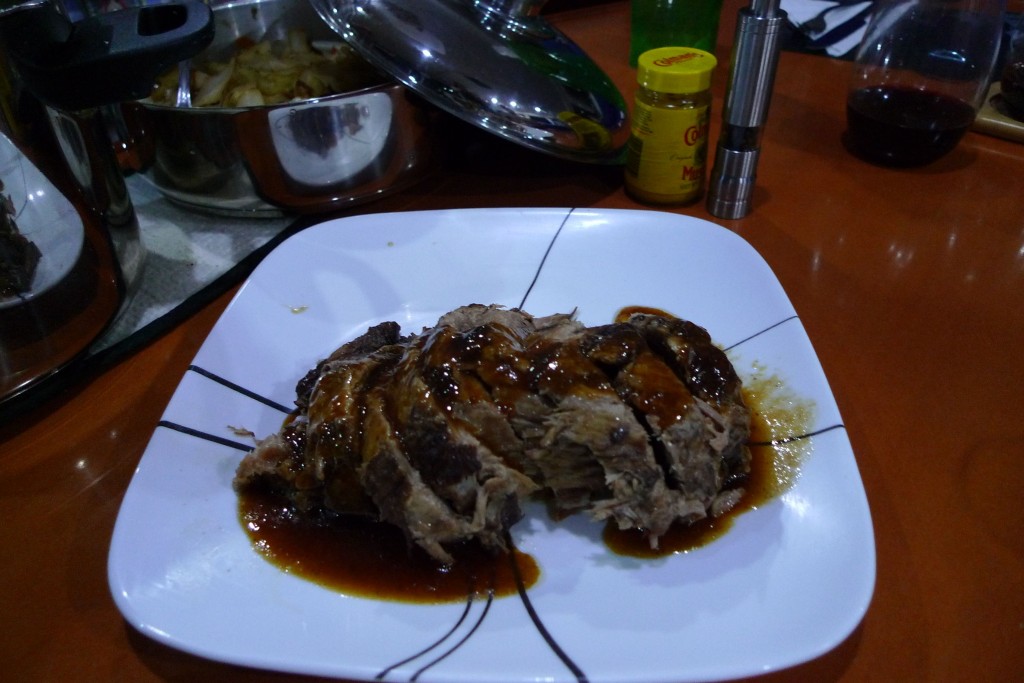An occasional series of practical recipes to cook aboard using the ingredients at hand.
INGREDIENTS
- Cupim – 1
- Cachaça – ½ cup
- Red wine – 1 cup
- Chopped onion – 1
- Garlic cloves – 2
- Thyme – sprig
- Soy sauce – tablespoon
- Worcestershire sauce – dash
- Oil for frying
- Lime juice – squeeze
- Xanthan gum – pinch
- Oil diaper
- Salt & pepper – to taste
Methodology
Cupim may readily be obtained from Pão de Açúcar in Sao Paulo. Sneak it past the sniffer dogs at customs in Miami and onto the boat. Sneak it past the sniffer dogs at customs in Chub Cay in the Bahamas. Marinate for 4 -24 hours in a mixture of cachaça (Mata Lua brand from Salinas in Minas Gerais), red wine (Running with Scissors), soy sauce, worcestershire sauce, thyme, garlic, salt and pepper.
Strain cupim and reserve marinade. Pat dry and brown on all sides in olive oil, Soften onions. Add reserved marinade and pressure cook at 15psi for 1 hour. Remove from heat, and once atmospheric pressure has been attained remove oil that has risen to the top using an oil diaper (can be purchased from any automotive store). Take out cupim and keep warm under foil. Strain cooking liquid and discard solids. Adjust seasoning with salt and lime juice.
Thicken with xanthan gum (~0.5%). Serve with English mustard, wasabi mashed potatoes and cabbage. Voilà!!!!



The food looks good! Yesterday I made Pork in Red Chile Sauce, using New Mexico Chiles..looks rather like what you made, but I am sure they taste different. The Brazilian Cow looks tasty! The water color looks very inviting, and it’s good to see you all!
The leftover gravy also works nicely with mashed potatoes, braised cabbage or any other food you want to send over the top to a delicious factor only known to a select few! A very nice dinner, and paired well with Bota Box.
So exotic and gourmet! I’m impressed with the many ingredients that you have on hand, as well as your growing knowledge of foreign cow anatomy.
I am there with that meal-condiments and all! I had to do a spot of research which I’m sure the boat buddies did to read about this dish, what’s a zebu and would it have a hump.
Internet bit- From Flavor’s of Brazil- “One cut of beef that I have frequently come across in supermarkets and butcher shops here in Fortaleza, and which I have enjoyed on a number of occasions, is called cupim. My curiosity was piqued the first time I spotted it in a butcher shop, as I knew that the word cupim meant “termite” in Portuguese. The red, boneless, fat-marbled piece of beef I saw on display seemed to have nothing to do with wood-eating insects (fortunately!). Research among recipes for cupim revealed that the cut is roasted or stewed, and is also sometimes featured in the menu of Brazilian churrascos, or barbeques. I actually tasted cupim for the first time in a churrascaria, a Brazilian meat-orgy style of restaurant where waiters circle the tables with cuts of meat on large swords, offering slices to diners. I found it very rich, quite fatty, and with a tender, stringy texture. For me, cupim is more a cut for pot-roast or stew and less for the grill. Cooking it in liquid disperses the fat (which can be skimmed off) and makes cupim less greasy.
Questions posed to Brazilian friends about what part of the body cupim comes from didn’t yield too much information at first, though one friend used the unfamiliar word corcova and pointed to his back. It was time to hit the internet to figure this one out. Corcova turned out to mean “hunchback” or “hump” and from there it required only a small bit of internet research to nail down exactly what cupim is. A large portion of the cattle raised for beef in Brazil are in fact zebus and not the same species as European and North American beef cattle. Zebus came originally from India and are the primary beef animal throughout the tropical world, as they are exceptionally tolerant to heat and drought. In fact, they constitute 80% of all the beef cattle raised in Brazil. The primary physical characteristics of zebus that distinguish them from taurine beef cattle are drop ears and a large hump atop the spine just behind the head. Bingo – there’s the cupim! It’s nothing more or less then the hump of a zebu.”
muito deliciosa